The US rental market has been thrown into turmoil. But in no major city have rents plunged from so high by so much so fast as in San Francisco.
By Wolf Richter for WOLF STREET.
San Francisco, which still has the most ludicrously expensive rents of any major city in the US, keeps getting less ludicrously expensive amid painfully low occupancy rates and massive churn of renters looking to upgrade and save – recent rent “recovery” rumors to the contrary.
The median asking rent for one-bedroom apartments in San Francisco in April fell to a new multi-year low of $2,600, down 30% from the peak in June 2019, according to data provided by Zumper:
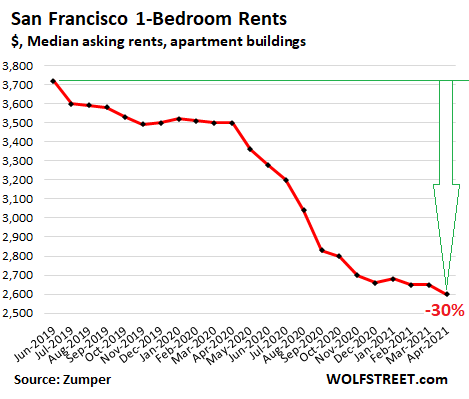
The five-county San Francisco Bay Area is also the only housing market in the Case-Shiller Index that is now infamous, amid a nationwide blistering melt-up of home prices, for condo prices that have declined compared to a year earlier and are at March 2018 levels.
In San Jose, the largest city in the Bay Area and part of Silicon Valley, the median asking rent for 1-BR apartments fell to a multi-year low of $2,050, down 19% from the recent peak it bumped into in July 2019, and then again in March and April 2020:
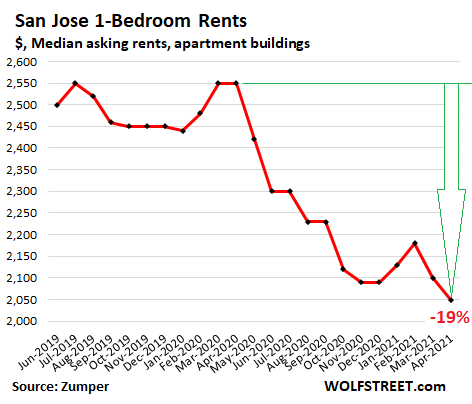
These “asking rents” are compiled by Zumper from rental listings on Multiple Listings Service (MLS) and other listing services. But they do not include concessions, such as the very common “two months free,” which lower the effective rents further.
“Median” asking rent means half of the asking rents are higher and half are lower. The rental units are in apartment buildings, including new construction, but do not include single-family houses for rent or condos for rent.
Rents for 2-BR apartments in San Francisco, after plunging for months, have been stable over the past few months, with the median asking rent stuck at $3,500, down 30% from the peak in October 2015 and down 27% from July 2019.
There is now a vibrant churn in San Francisco, as many of the renters on month-to-month leases are shopping around and browsing through the large number of vacant units.
How bad is it? 16% of the large apartment buildings in San Francisco whose mortgages have been securitized into CMBS have an occupancy rate of less than 80%, according to Trepp, which analyzes CMBS. By comparison, in numerous cities, such as Phoenix, there are no such buildings with an occupancy rate of less than 80%. None!
So people are using the plentiful vacancies and the deals they get from landlords, such as “two months free,” to upgrade to bigger and nicer units. Landlords that offer the right kind of deals can get their units filled. Other landlords sit on vacant units, waiting for better times.
And some of those upgraders go from one-bedroom apartments to two-bedroom apartments. This classic flight to quality at the same or lower price is changing the mix somewhat. And such changes in mix can skew median rent data upwards with data providers that offer one combined median rent figure for all types of apartments.
These data providers that put 1-BR and 2-BR apartments into the same bucket may show a median rent increase in their summary figure, skewed by this shift in mix to bigger nicer units, without there having been any increases in asking rents per apartment type. And of course, this has played out on the front pages of the local media.
In San Jose, the median rent for 2-BR apartments has been around $2,660 for several months, after having dropped 13% from early 2019. Here too, the vibrant churn and flight to quality has created some stability of larger nicer units at a lower price.
Affordability Crisis Moves Inland.
There are now all kinds of reports on the work-from-homers who have left San Francisco and Silicon Valley for cheaper pastures. Many of them found those cheaper pastures within two to three hours by car from San Francisco, and rents in those markets have exploded under the influx of people with suddenly a lot of extra money to burn.
In Sacramento, about 100 miles east of San Francisco, the median 1-BR asking rent in April jumped by 15% from June 2019 to $1,450:
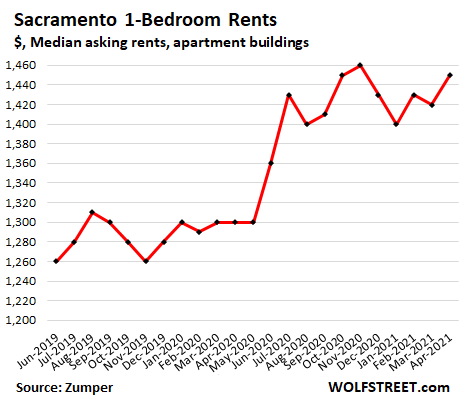
In Fresno, about 150 miles southeast of San Jose, the median 1-BR asking rent in April has soared by nearly 30% from the recent low point in September 2019. Clearly, some of these shifts have been going on before the Pandemic, and the Pandemic accelerated them:
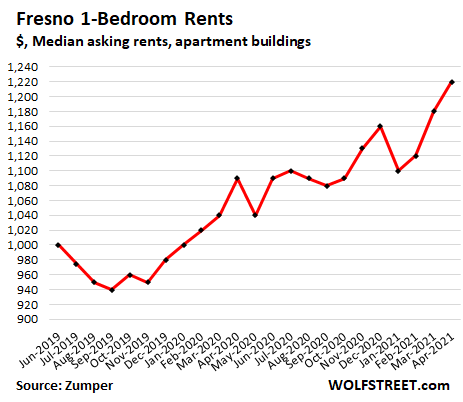
And the difference shrinks.
Given the swooning rents in San Francisco and the surging rents in Sacramento and Fresno, the difference has collapsed. In San Francisco, the rent dropped from $3,720 in the summer of 2019 to $2,600 in April. In Sacramento, over the same period, the rent rose from $1,260 to $1,450. The rent difference between the two cities collapsed by 53%, from a difference of $2,460 in July 2019 to just $1,150 now.
In other words, renters who made the move in July 2019 saved $2,460 a month in rent. Renters who made the move in April 2021 saved only $1,150. At some point, if the difference narrows further, the savings aren’t worth the move, and the motivation to move to these cheaper pastures disappears.
And the rent spread between San Francisco and Fresno has collapsed by 49%, from $2,720 in July 2019 to $1,380 in April:
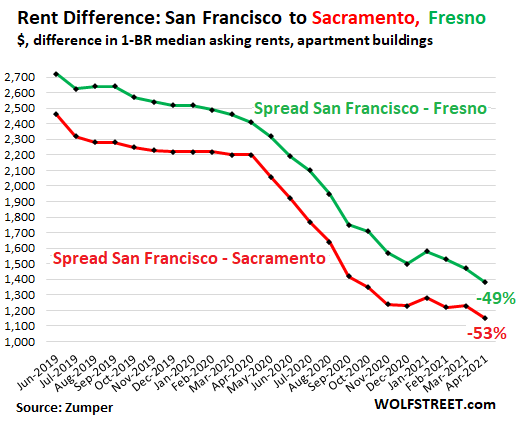
Similarly, the difference between 1-BR rents in San Jose and Sacramento has collapsed by 53%; and the difference between San Jose and Fresno has collapsed by 47%:
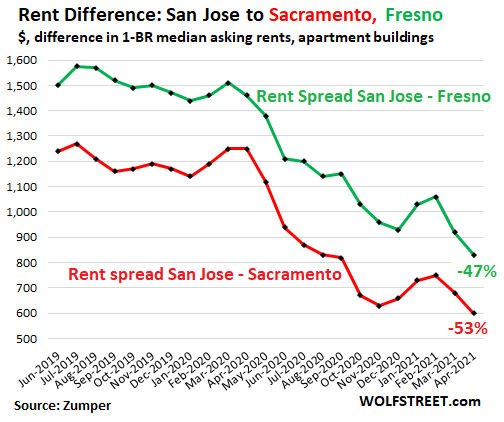
It doesn’t take much for the exodus from a large market like the Bay Area to cause major rent turmoil in smaller surrounding markets, such as Sacramento or Fresno, and this may continue to put some upward pressure on rents in those inland cities. But the sharply narrowing spread in rents makes the move less of a money-saver and less of a motivator than it was a year ago.
A similar scenario has played out across the US, with shifts from the most expensive rental markets to cheaper pastures, triggering the corresponding plunges and spikes in rents. That the US rental market has been thrown into turmoil is an understatement. And this is just an example — though in no major city have rents plunged from such a high pedestal by so much so fast as in San Francisco.
Enjoy reading WOLF STREET and want to support it? You can donate. I appreciate it immensely. Click on the mug to find out how:
![]()


San Francisco rents are telling us love mojo futures are trading in backwardation. The city is and was a Cruise ship that never weighed anchor.
Big Tech workers are literally like cancer.
Forcibly relocate Fakebook, Google (WE DO EVIL AND ONLY EVIL), and Silicon Valley to China. Oh and Boeing too. And Amazon. Tax the rich out of existence. Reclaim our nation and govern for the people by the people. If they don’t, freeze those corporations out of SWIFT and terminate their existence with in the US dollar.
Seriously, you don’t think XJP has enough advantages?
If rents are down 50% shouldnt prices for apartment building be down by the same amount?
What’s a good /popular area for renting or buying a rental in San Francisco?
Just a speculation, not an investment advice.
A rental unit in Austin where a lot of tech companies and techies are moving to, will give you a better return.
The RE tax rates in Austin are really high and rising. They have a new train system going in and road construction everywhere. This could put a big dent in ROI. Plus, I’m not so sure the job market is as good as advertised.
Tenderloin is up-and-coming. Good walk scores.
Walk to what? The illegal alien sanctuary city protected class of Honduran Fentanyl dealers down the block? Sixth Street Skid Row?, the BART stops at which the drug dealers from Oakland arrive? The shock corridor gauntlet of “New Market Street?”
The effects of San Francisco politics have metastasized to pretty much every neighborhood.
At least there are still the excellent public schools…Bwahahahaha!
3 shot on Market Street last night. Easy commute!
The library, the opera, the symphony, restaurants, union square, Zuni Cafe, farmers markets.
It takes time for cause and effect to impact the market. Lower rents begin cash flow problems, which may go on for years before they force desperation sales.
Once the process begins though, it can have a domino effect on multiple property owners who have used leverage from one property to finance the next one. I have seen the loss of a single property cause the collapse of an entire portfolio.
The COVID infection rate is dropping again. They hope to have more reopenings by the fourth of July. Apartment buildings might be safe for renters again.
And, as pointed out.
With landlord concessions and free months bait for new tenants, it is probably a 50% drop from peak for the actual money in the landlord pocket drop.
Gee, I hope no one overpaid for their rental investment.
“The median asking rent for one-bedroom apartments in San Francisco in April fell to a new multi-year low of $2,600, down 30% from the peak in June 2019, according to data provided by Zumper:”
In this rental market, the arbitrage rate is slow.
Good update.
As a foreign observer the inhabitants who lived in the condos where are they going now and for what reason are they leaving? The homework excuse will be over once Covid is over and employers have realized that there are many gaps in teleworking for many workers, so the reason must be another. One reason could be the expected increases in all taxes and people choose to go to the states where there are fewer taxes or maybe there is another underlying reason for this great migration of about 9 million Americans who have changed residence to go to the country. Been with a more peaceful and secure future because they are better managed?
N. Carolina usually ranks about # 4 as a in-flow state, but more from NY and NJ I think.
Most all of the state can be developed if it pencils out. We get a lot of rainfall so there aren’t water issues. Fed and state own very little of the land. A lot of small farms that don’t make much money can be sold. Do I want more growth? Not really, as it can drive up prices, but you can still find cheap rural living.
I’d guess we’re seeing another cycle of the big city / suburb cycle. Whenever commuting to work gets fast and inexpensive, people move to the suburbs. Look at the Gilded Age mansions in downtown areas that became decrepit in the 1950s and 60s when cars became widespread.
As traffic jams resulted, and commutes got more miserable, downtown condominium living looked good. This lasted until Covid shut down all the benefits of city life.
Now that telecommuting is practical, we’re again seeing a move away from downtown life.
The way it is going Fresno, Stockton and Merced will soon be gentrified and the farm workers will have to live in North Beach and Palo Alto.
I kinda hope so. I own 20 acres on the NW corner of Modesto, near to Hwy 99 and the main E-W artery to Sonora and parts beyond. When my dad bought the property over 40 years ago he believed it would be a prime candidate for development someday; we’re still waiting.
It’s Not Over according to this tabloid.
Sure you remember PlayFair
Spokane Washington?
Golden Gate Fields, Dead Horse Bay (our ace in the hole).
Part of the Californian culture and a spate of racecourses opened in the second half of the century.
There you have mixed fortunes rising land values, anti-gambling crusaders, and bitter rivalries.
Horse racing is dying as a sport. Ever since Reagan disallowed breeding farms their business tax write off its. Been on a slow decline. You left out Bay Meadows and Longacres . I was a race tracker from 1978 to 2000. Still am I suppose. We are like the cockroaches even an atom bomb can’t take it out of us
Slot machines are for old women. Taking away the tax writeoff is the best thing that ever happened to the sport. The races were suddenly competitive. SoCa racing is elitist, but the internet allows you to plug into any regional track you like, cheap claimers running their heart out.
I don’t think horse racing is dying. Seems to me more people are getting excited about it. My local is Golden Gate Fields and I’ve noticed a lot of millenials showing up at the track over the last couple of years. Was really sad to see Bay Meadows go but on that last day I hit the last 3 races on the card which at least left a really good lasting memory of the old place.
Spot on Sir,
I only wish more hard working people realize the damage to America and her fine system by the turn coated thieves masquerading as elected public servants.
Those like you are knights of men!
Apache Lark in the third to place.
Best put her in for a trifecta…. shezaa doesssa,
peace out
Rents will bounce back unless people have left CA altogether. We’ll know soon enough.
I’d be more worried about the tech ‘gold rush’ coming to and end. SF will end up like all mining towns.
SF has had many gold rushes, even a literal one, and it no doubt will have more.
People have definitely left CA and NY. Both have lost a congressional seat according to the new census calculation. Texas gained both of those seats.
The north and midwest lost seats which were gained by the south.
Collecting any money on the Sunshine Coast is a perfectionist art.
Especially housing as Fannie- Freddy (sp) located on the Gold Coast!
It’s no wonder why a honest person finds it impossible to earn a simple payment and not at the same time be robbed (robbery) from their coffers.
All the while doing the right thing.
This needs a reevaluation to say the least.
SF 1BD rent : there was a bubble in 2000. The next bubble lasted until 2019. In between them, there was 2010 low.
The next low might be in : 2030, or 2036.
The rent deflation in real terms can last between additional : 9 years to 15 years.
After Giuliani raid, NYC 1BD will not do better.
The wealthiest 10% own 89% of stock and mutual fund shares. 53% of that is owned by top 1%. Whereas, the wealthiest 10% own only 45% of the RE.
The stocks gained $22.4 trillion in value from last year’s bottom, while nation’s total home equity rose only about $1.3 trillion from the end of last year’s first quarter through Dec 31.
(Source: ProPublica)
How to lie with statistics: measure the gain from the bottom ignoring the 40% decline immediately before.
I just checked an apartment building in the east bay that I rented at for 2.5 years and have watched for longer. They’re offering $500 off moving expenses and first month free. I’ve never before seen them offer anything but rent increases, and I moved out because of it.
It’s a glimmer of hope for long suffering rent serfs.
Update, I just got my notice of rent increase for my current apartment — 5% up, still east bay.
Or a more accurate headline might be rents in SF are back to around 2014 levels, nominal. The year when nominal rents in SF first passed the 2000 level rents during the first dot com bubble.
Now when you start doing the real not nominal numbers using the cost of living inflation in San Francisco based on real world spending habits and household cost (not the makey upey Federal numbers) I’d say for rentals outside the hipster / dot commer areas current numbers are somewhere around 1997 levels. In real terms. Based on a four decade direct experience of paying those bills.
SF is different. Very different. Unless you get the in / out timing exactly right there is no real money in rentals. Just capital gains. And that is completely dependent on exit timing too. And the property not getting knocked / burned down in the next Big One. Every house I’ve ever rented in SF had interesting cracks / subsidence / patches due to earthquake damage. Mostly due to the 1957 Daly City quake in fact. Loma Preita mainly just knocked furniture over. And all creaked in interesting ways after a good sized tremor.
SF is different. Very different.
Jdog the drama queen back at it again. No, it’s about the money dummy. People who aren’t terminally online boomers don’t spend that much time ruminating over politics. They’re making a financial decision.
Liberalism was rejected in 1981 by Reagan. Ever since then it has been movement conservatism. You are still blaming liberalism?
1) The only different between the TP bubble and the RE bubble is
the amount of zeros.
2) Since there relatively less transactions of condos in SF
the statistic is positively biased.
3) The IRS know exactly when u bought and when u sold and for how much.
4) You can claim transactions cost, a new roof, a new BR, or other improvements bs, but the IRS don’t care.
5) They will hit u with what they think is appropriate to your pocket
and if u call them to protest, they never answer back.
6) If u are late, they ad penalties & interest.
7) Once the IRS nailed u, the state will followup.
8) Now u get hit by both the IRS and your state.
9) The only way to stop this vortex is to shut up and pay. Don’t forget to pay your accountant & lawyers for their efforts, otherwise they will start to beg u….
Slave mentality.
I figured there would already be this comment here. I have to agree. Bad policy can only go so far before those who voted these clowns in finally, themselves, got disgusted and decided to leave. Only problem is that a lot of them are coming to San Diego and actively doing their best to turn us into a cesspool. Keep an eye on San Diego, though. In the very near future you’ll be hearing about a blue on blue battle against the insane housing policy they’re pushing down our throat. Orange guy warned it was coming and turns out we’re one of the test beds fir it…low income apartments coming in to single family neighborhoods. Bunch of SF types trying to ruin this place too
Wonder how SF stacks up against other comparable world metro areas? Comparison to the domestic cities seems inequitable, as was stated above, it’s a different place. Lived in Texas for many years, it’s political freedoms derived from the needs of survival in a harsh barren land. No Bureau of Reclamation to shunt water around the state like in California. If the Imperial Valley was around Waco, it’d still be cattle desert. Austin was getting crowded forty years ago, and it’s an environmentally fragile area, the Edwards Plateau and recharge zone encompasses much of the Hill Country. Motorola semiconductor fab in Oak Hill had water shortages in 1983. When the population was half of today’s. It’s a bone dry place with deadly but infrequent floods. Electrical infrastructure was overloaded even then, and the city of Austin sells power very dear. And nothing else cheaply. In the same early eighties time frame, electrical meter base fees started at $500/simple house replacement and went into five figures for 480/277volt three-phase retail. For a meter base. Not the inspection and re-inspection fees, connection charges, monthly “contribution” to city power system build-out added use percentage,etc. worlds best barbecue, though. And californium people need feeding up.
SF had thirty eight Fortune 500 companies last year at this time. Other than installed-base considerations, don’t know what they’re hanging around for. A couple have left for- where else?
the big T.
At least from a real estate point of view the two huge distortion in SF in the last 60 years have been the building out of the last availbel low density development land, the Sunset in the 1930’s to the 1960’s, and then in the late 1960’s “anti-growth” of recent incomers stopped almost all up-denistification of the City for decades.
This had a delayed effect due to the City losing over 100K population between 1950’s and 1980’s but when the population started increasing again by the mid 1990’s the real pressure on rentals really started. I remember a news story, would have been 1996 or so, pointing out that due to re-conversion of sub-divided houses even though the population had gone up almost 40K the previous few years the City had actually lost a few hundred residential units.
It was only in the late 1990’s the City actually started adding residential units in any number for the first time in decades. But not that many compared to the building rate from the 1910’s to 1960’s.
The second big distortion is to single family housing prices. There are many tens of thousand of single family homes (off the top of my head 70k(?)) in SF, mostly build 1910 to 1960. These had a fairly typical turn over rate until the 1980s when due to Prop 13 the market just ground almost to a halt.
Since then in areas with very large numbers of single family houses like houses in the Sunset usually only come on the market for three reason. The owner dies of old age, the owner moves out of state, or its a foreclosure. Due to the lock in with property taxes and the repeated bubbles if you have lived in a house for more than a decade if you move to another house of the same prices in state your property tax will at least double or treble. This by itself has removed most of property mobility from the market.
Based on what I have seen in equivalent areas in SF and Seattle (where there is no property tax valuation lock in) the owner mobility rate in SF is about 10% to 20% of Seattle. All due to property tax. On the last block I rented a house on (all equivalent houses) the next door neighbors property tax was almost double my landlords and the last hold out of the original owners on the block was paying less than 10% the property tax of my landlord. All houses had about the same market value. In fact my landlord was paying more property tax than some people I knew in Santa Barbara where their beautiful mansion and even more beautiful grounds had been in the family since the early 1920’s. Because now your very low Prop 13 property valuation can be inherited by your kids. And their kids.
So its a totally dysfunctional market, all the way down. But thats California for you. It always been like this. Since the days of the Californios. You know you’ve gone native when not only does all this make sense but you no longer see any problem. You just go with flow.
Excellent synopsis.
Thanks to Prop 19, kids and grandkids are out of luck. By the way, if a family has lived there for a hundred years, or 43 years since Prop 13, and pays “low taxes” now, just remember that they have paid one hundred, or 42 cumulative years of property taxes in dollars that had a much higher value.
Not how property taxes work in other states. Or in pre Prop 13 California for that matter. When until a few years before the Prop passed commercial property taxes cross subsidized residential. It was the removal of the cross subsidy (and Jerry Browns incompetence), that caused the Prop 13 fiasco. But thats another story.
I just checked the house property tax. Its about $5K a year for house with a market valuation well over $5M. The house across the street sold last year for just over $5M. A horrible tasteless Mac Mansion of a beast. The property tax will be well over $50K.
The 1920’s house is a beautiful low key Spanish revival house. Not a George Washington Smith but very much in that style. And unlike the McMansion which covers most of a much smaller plot, has a very nice grounds.
The kids will inherit the property tax valuation. I know of at least one $10M plus mansion in the neighborhood where the kids did precisely than. That house was bought in the 1940’s I think so they might be paying as much as $10K or $15K in property tax. Which is about what my landlord is paying for a typical 2/3 bed pre War house in the Sunset. Valuation over $1M at the moment but thats mostly the land value. The building replacement cost (pre Covid) would have been $400K max.
In places like San Francisco once you realize that its not the value of the house per se but the land its built on that goes up and down then the whole merry go round of property bubbles starts making a bit more sense. Its the zoning and legal impediments in how many residential units can be built on that plot of land that really drives very high inflation rates in rentals.
If left purely to the market the higher the location demand the higher the density of the residential units. A basic fact of economics that has been building higher density towns and cities for more than 7 thousand years by this stage. But quiet beyond the supporters of “anti-growth” politics for the last 50 plus years.
You say the problem is due to prop 13, I say the problem is due to fiat money.
There is water east of the Mississippi R.
***TDS ALERT***
You too can help rightsize San Francisco rents, just flag any Craigslist posting for a one bedroom costing over $1500, or a studio over $1,000.
Let them sit empty for a couple of years, that’ll get the landlords to lower rents, or sell, if their numbers didn’t pencil out.
When will the remaining voters get wise and flush the nation’s political turds that have flowed into city hall?
What in the world got me moderated this time? It’s almost like a drinking game.
Either way. San Diego is becoming SF of the south. Can’t remember what else I wrote
Your comment was in a thread that had started out with a drive-by line of BS in a longer comment that then other comments started reacting to, which started hijacking the comments with BS and counter BS. So the first comment had to go, and everything attached to it went with it.
I take solace that it wasn’t me this time
With landlord concessions and free months rent for new tenants, when it comes to units that are rent controlled, a landlord will most likely want to keep the official rent high because he is limited on raising rents down the line, so he gives all these concessions.